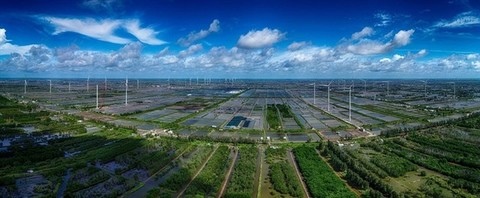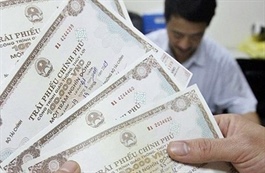Navigating challenges in the green bond market
Navigating challenges in the green bond market
Despite the Government's approval of the Green Growth Strategy for the 2021-2030 period several years ago, the allocation of resources for environmental protection remains highly constrained, particularly when it comes to utilising green bonds as a funding channel.

Hòa Bình No 5 wind farm in Hòa Bình District, Bạc Liêu Province. Green bonds are focused on sectors related to climate change, such as transportation, energy, recycling, construction and waste management. — VNA/VNS Photo |
In recent years, the Vietnamese Government, along with various ministries and local authorities, has implemented coordinated measures to promote sustainable economic development.
The Prime Minister has issued the Financial Strategy until 2030, emphasising the mobilisation of domestic and foreign resources for green economic activities and environmental protection.
Despite regular budget allocations for environmental initiatives, Việt Nam still needs to mobilise green financial resources from the market, primarily through green bonds, to support climate change adaptation and sustainable growth.
A report from the Financial and Banking Department of the Ministry of Finance (MoF) showed that the green bond market has experienced significant growth in countries such as the US, UK, France, Germany, China, South Korea and Singapore. Green bonds are focused on sectors related to climate change, such as transportation, energy, recycling, construction and waste management.
In Việt Nam, a legal framework for government, local government and corporate green bonds has been established. Funds raised from green bond issuance must be accounted for and used for environmentally beneficial investment projects. Issuers are required to provide information on environmental impact assessments and permits for investment projects. Both issuers and investors in green bonds enjoy incentives as per the law.
The MoF has implemented favourable pricing policies for services in the stock market related to green bonds. This includes a 50 per cent reduction in fees for registration, management, trading and securities custody. Public investment projects funded by government or local government green bonds will receive prioritised capital allocation.
A good example of effective green finance policy is Singapore, which has achieved top rankings in the ASEAN region and internationally in terms of green finance, Doctor Hồ Quốc Tuấn of Bristol University said in a 2024 special report on banking in Việt Nam.
Since 2019, the Monetary Authority of Singapore has introduced a Green Finance Action Plan and established the Green Finance Industry Taskforce to make the country a leading green financial centre in Asia, emphasising sustainable finance as a means to meet emission reduction targets.
According to Nguyễn Quang Thuân, CEO of FiinRatings, the issuance of green bonds has become a global trend, doubling in the past three years. Vietnamese companies are now joining international green bond programmes.
Due to Việt Nam’s ambitious economic growth goals, there is a high demand for capital across industries. The green transition presents opportunities for businesses to access various funding sources, including bank loans, bonds and domestic and foreign financial institutions.
Currently, the total value of sustainable bonds, including global green bonds, has surpassed US$3 trillion, and the annual issuance value is expected to reach around $5 trillion by 2025.
Thuân hopes that Vietnamese companies can seize about 1 per cent of this, approximately $50 billion.
The Government is also providing support through interest rate incentives and tax benefits to encourage more businesses to participate and achieve a commitment of zero emissions by 2050.
Experts see this as an opportunity for businesses to adopt sustainable development models and invest in green sectors during the economic transition.
Not an easy game
Despite favourable conditions, development of the country’s green bond market has been limited.
The market started in 2016, when HCM City issued VNĐ3 trillion ($118 million) in 15-year local government bonds for budgeted projects, including 11 environmentally focused ones. In the same year, Bà Rịa - Vũng Tàu Province issued VNĐ500 billion in five-year bonds for similar purposes.
In July 2022, EVNFinance, a financial company, issued $73.7 million in green corporate bonds with a 10-year term and an interest rate of 6.7 per cent per year. BIDV also successfully issued green bonds worth VNĐ2.5 trillion in 2023.
However, recent reports suggest a decline in Việt Nam’s green bond issuance, with only around VNĐ3 trillion in the first ten months of 2023 compared to VNĐ37 trillion in 2021.
To effectively promote green bonds, experts emphasise the need for Việt Nam to enhance its legal framework, as current regulations lack specific guidelines on the roles and responsibilities of involved parties.
Nguyễn Trí Hiếu, an economic and financial expert, highlights the financial challenges in environmental protection in Việt Nam, specifically regarding green financing.
While the Government approved the National Green Growth Strategy for 2021-2030, the issuance of green bonds and loans for environmental projects remains limited.
Globally, around $2.4 trillion of green bonds have been issued, but in Viêt Nam, only three companies have issued a small volume of green bonds.
Hiếu raised concerns that without faster progress, green bonds may remain a nominal concept in the next several years, as both the conventional bond market and the green bond market face difficulties.
Tuấn from Bristol University said that green bonds have lower liquidity risks compared to conventional corporate bonds and positively impact the stock liquidity of companies.
However, the high costs associated with green bond issuance, including advisory services, credit ratings and project certification, pose challenges and hinder motivation for issuance.
Market structure issues, such as the lack of credit rating services and underdeveloped exchanges, along with limited participation from institutional investors, lead to the majority of issuances seeking foreign assistance or financial support from international organisations.
To mobilise funds for climate change solutions and sustainable growth, Tuấn emphasises the need for Việt Nam to enhance its legal framework, particularly focusing on promoting green bonds. This includes developing tax and fee policies that support climate efforts and encourage green investment while reducing incentives for industries with environmental risks.
In terms of incentives for green bonds, the MoF is studying proposals to provide tax benefits for corporate and personal income generated from these bonds.
It will work with the Ministry of Natural Resources and Environment on a decision from the Prime Minister to classify green incentives based on international practices and the specific context in Việt Nam.
























